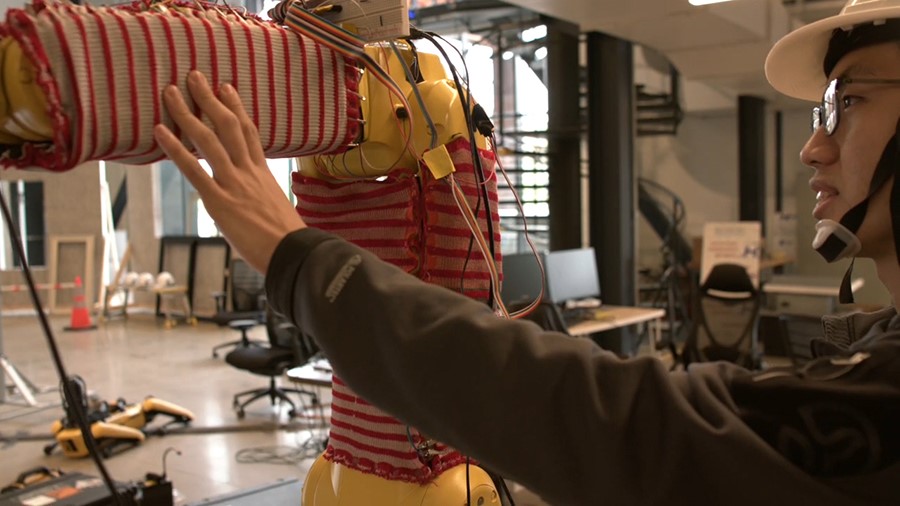Sweater-Wrapped Robots Sensing and Responding to Human Touch
The remarkable attributes that contribute to the comfort and ease of wearing a knitted sweater happen to align with the qualities that can greatly enhance the interaction between robots and humans. [1]
A team of researchers from Carnegie Mellon University's Robotics Institute has introduced a groundbreaking innovation called RobotSweater. This unique creation encompasses a machine-knitted textile "skin" with the remarkable capability to perceive touch and pressure. [1]

Figure 1. RobotSweater.
Figure 1 shows RobotSweater. Similar to the flexibility of skilled knitters who can transform various yarns into socks, hats, or sweaters of different sizes and shapes, the knitted fabric of RobotSweater can be tailored to accommodate uneven and complex three-dimensional surfaces. [1]
"Knitting machines can pattern yarn into shapes that are non-flat, that can be curved or lumpy," said James McCann, an SCS assistant professor whose research has focused on textile fabrication in recent years. "That made us think maybe we could make sensors that fit over curved or lumpy robots." [1]
Once the fabric is knitted, it serves the purpose of enabling the robot to "sense" human touch, which holds significant value in safety-critical industrial environments. Unlike existing solutions in industrial human-robot interaction, such as rigid shields, the RobotSweater fabric offers a distinct advantage. It can cover the entire body of the robot, including areas that require deformation, ensuring comprehensive and accurate detection of human contact. [1]
The knitted fabric of RobotSweater incorporates a clever construction comprising two layers of conductive yarn, woven with metallic fibers to facilitate the conduction of electricity. Nestled between these layers is a net-like structure with a lace-patterned design. This intricate arrangement allows for a fascinating mechanism: when external pressure is exerted on the fabric, such as through human touch, the conductive yarn comes into contact, forming a closed circuit. This change in circuitry is then detected and interpreted by the integrated sensors, enabling the robot to perceive and respond to the tactile input received through the fabric. [1]
"The force pushes together the rows and columns to close the connection," said Wenzhen Yuan, an SCS assistant professor and director of the RoboTouch lab. "If there's a force through the conductive stripes, the layers would contact each other through the holes." [1]
The team encountered an additional challenge when it came to connecting the wiring and electronic components to the soft textile. After numerous samples and tests, they discovered a successful solution: wrapping the wires around snaps attached to the ends of each stripe in the knitted fabric. This approach proved to be both cost-effective and efficient. In fact, it is so practical that even hobbyists involved in the creation of e-textiles, textiles with electronic elements, can easily employ snaps for their projects, as highlighted by McCann. [1]
In their research, the team demonstrated that pushing on a companion robot outfitted in RobotSweater told it which way to move or what direction to turn its head. When used on a robot arm, RobotSweater allowed a push from a person's hand to guide the arm's movement, while grabbing the arm told it to open or close its gripper. [1]
In future research, the team wants to explore how to program reactions from the swipe or pinching motions used on a touchscreen. [1]
Source: Carnegie Mellon University
References:
- https://www.cs.cmu.edu/news/2023/robot-sweater
Cite this article:
Hana M (2023), Sweater-Wrapped Robots Sensing and Responding to Human Touch, AnaTechmaz, pp.444

